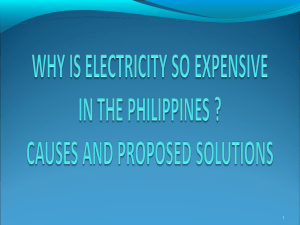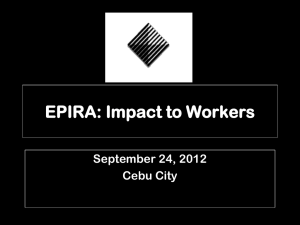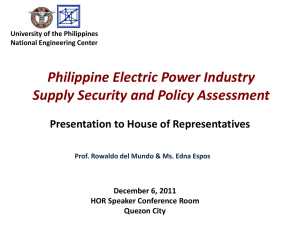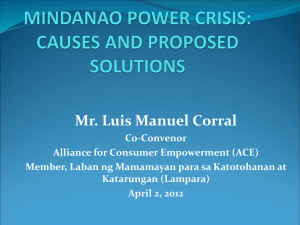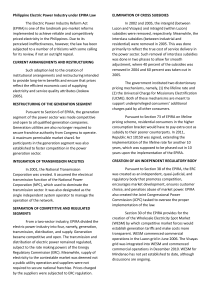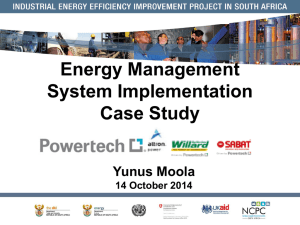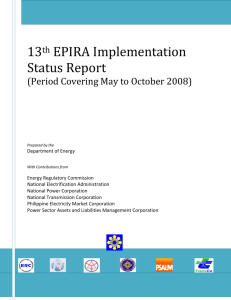Why is electricity so expensive in the Philippines
advertisement
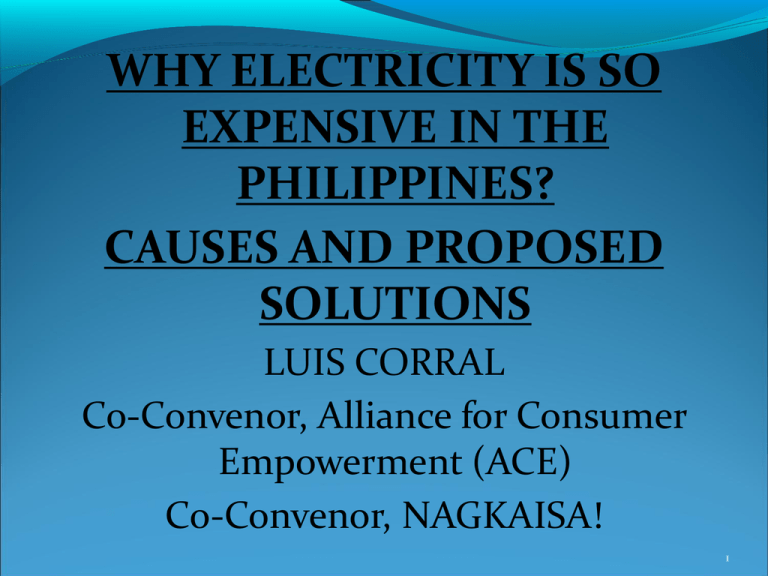
WHY ELECTRICITY IS SO EXPENSIVE IN THE PHILIPPINES? CAUSES AND PROPOSED SOLUTIONS LUIS CORRAL Co-Convenor, Alliance for Consumer Empowerment (ACE) Co-Convenor, NAGKAISA! 1 EPIRA HAS AFTER 10 YEARS ILLUSORY GAINS • Privatization of 90% of NPC assets to • • • • promote competition to lower rates “Corrupt/Inefficient” government out of power sector Entry of competent and efficient and private players Private players with deep financial capacity and international experience Decentralized independent planning 2 EPIRA AFTER 10 YEARS • • • • • • REAL LOSSES Vertical integration of privatized IPPs with DUs No competition within franchise area Sweetheart Deals between generation and distribution sectors Increasing power rates and yet continuing brownouts Energy security at the mercy of private sector No investment in renewables 3 PHILIPPINE POWER RATES: ASIA’S HIGHEST PHILIPPINES -------US$0.2460/kWh Japan---------------US$0.243/kWh Singapore---------US$0.22/kWh Indonesia----------US$.092/kWh Thailand------------US$.086/kWh (source : 2010 IEC study) 4 WORLD’SInternational HIGHEST POWER RATES Energy Agency (Q1 2011) RESIDENTIAL (/kWh) Denmark ---US$0.3563 Germany --- US$0.3248 Italy --- US$0.2632 Austria --- US$0.2576 PHILIPPINES- US$0.2460 Ireland --- US$0.2326 Japan --- US$0.2322 Belgium --- US$0.2317 Netherlands --- US$0.2212 Sweden --- US$0.2180 (Source : 2010 IEC study) 5 WORLD’S International HIGHEST POWER RATES Energy Agency (Q1 2011) INDUSTRIAL POWER RATES (/kWh) Italy --- US$0.2581 Slovak Republic – US$0.1691 Japan --- US$0.1544 Turkey --- US$0.1509 Czech Republic – US$0.1439 Ireland --- US$0.1372 PHILIPPINES ---US$0.1320 Belgium --- US$0.1245 Netherlands --- US$0.1230 Luxembourg --- US$0.1219 (Source : 2010 IEC study) 6 • • • • • EPIRA: REAL LOSSES FOR FILIPINOS Undercapacity in power Threats of brownouts No energy road map Power sector left to the vagaries of the market Gencos and distribution firms can rig the market: Create artificial shortages to drive up rates or to justify bringing in dirty coal or expensive diesel 7 IMPLICATIONS OF HIGH POWER RATES: Philippines becomes uncompetitive regionally Private Public Partnership viability suspect Current business locators might transfer to Indonesia, Thailand, Vietnam, Cambodia or even Burma Investors moving to Asia Pacific, we might miss out on the boat Surrender of power industry to socially and politically unaccountable private sector Consumers left with a take it or leave it choice: expensive power or no power at all 8 WHY AND HOW DID THIS HAPPEN? EPIRA unbundled the natural horizontal monopoly of the industry: generation, transmission, distribution, supply unbundled. Theory that the generation firms would compete with one another, thereby lowering rates in generation sector. Gencos divided country among themselves: no competition in areas where they put up generation plants. Gencos and DUs vertically re-integrated whereby Genco A sells power to DU A through a “sweetheart contract” where both parties are cross owned. 9 WHY AND HOW DID THIS HAPPEN? • In Generation Sector • Lobby of Gencos in the drafting of EPIRA The Generation sector under EPIRA defined as not being a “utility”. Only utilities are subject to the 12% RORB ceiling of the Public Utilities Law. The Return on Rate Base of Gencos ranges from 29% to 40% because there is really no competition and there is no limit to the profit that they make. Cross-ownership was allowed under the EPIRA Regulatory capture of ERC 10 WHY AND HOW DID THIS HAPPEN? Unbundling created four (4) middlemen structures to jack up the rates at each stage: (i) generation; (ii) transmission; (iii) distribution; and (iv) aggregation Each unbundled component in effect allows an additional rate because of the legal fiction that there are four industries in what is really a natural monopoly The PSALM holds NPC hostage through an Operations and Management Agreement (OMA) whereby all the gross receipts from the operations of the NPC must be turned over to the PSALM. RESULT: Additional “Stranded Costs”. 11 12 WHY AND HOW DID THIS HAPPEN? Polticized and captured ERC. ERC: Performance-Based Rate-making Formula (PBR). PBR allows distribution utilities to collect additional rate increases if it meets certain benchmarks. (eg, new connections, restoration of downed lines, increased efficiencies in operations, response time to complaints) PBR performance hurdle was drawn up by utility itself not by independent regulator, therefore it is self-serving and easily met. IN OBTAINING ITS FRANCHISE DUs PROMISED CONGRESS THAT THEY WOULD RESTORE DOWNED LINES AND PUT UP NEW CONNECTIONS BECAUSE THEY ARE COMPETENT AND CAPABLE. WHY SHOULD 13 WE PAY EXTRA FOR WHAT THEY PROMISED? WHY AND HOW DID THIS HAPPEN? In Distribution Sector PBR allowed distribution utility to charge extra for: (i) Connection of new applicants; (ii) Putting back lines brought down by typhoons; (iii) Increased street-lighting and lighting for public areas such as parks; and (iv)Better efficiency in operations. BUT THESE ACTIVITIES WERE PROMISED BY THE DU AS BASIS FOR AWARD OF FRANCHISE. TO ADD INSULT TO INJURY PBR IS EXPRESSED IN A COMPLEX, INCOMPREHENSIBLE ALGORITHMIC FORMULA. HOW CAN WE INTERVENE? 14 POLITICAL ANTECEDENTS •Non-existent/immature consumer movement in the Philippine •Very small middle class I •Immature capital markets •Lack of understanding of power industry in the mass media •Lack of genuine consumer representation in the ERC •USAID funded lobby to privatize NAPOCOR, used NGOs that w in cahoots with high government officials pushing privatization •Pressure from the ADB, the IMF, and the World Bank “IMF Letter to Speaker Noli Fuentabella” •Portrayal of oppositors as ideological “crazies” “FDC Manlilinlang!” 15 •Congressional PAYOLA: PHP 500,000 each! WHY AND HOW DID THIS HAPPEN? •FAKE” CONSUMER GROUPS RECEIVING GRANTS FROM THE USAID, AUSAID, AND IFIS TO DEODORIZE EPIRA. THEIR PROPAGANDA: “FIGHT FOR CONSUMER CHOICE BY SUPPORTING EPIRA” “END THE MERALCO MONOPOLY AND CREATE THE POWER OF CHOICE.” “END THE CORRUPTION AND THE HIGH POWER RATES OF NAPOCOR 16 HISTORICAL OVERVIEW OF THE POLITICAL DYNAMICS THAT CONTRIBUTED TO THE HIGH TARIFFS FVR Administration. The 35 IPP Take-or-Pay Contracts left for consumers or taxpayers to assume as stranded costs. Government sold NPC assets debt-free. As a result we were saddled with US$ 11 billion in stranded liabilities. These liabilities were take or pay contracts with IPPs to purchase power whereby GOP takes the promised capacity from the IPP, AND EVEN IF GOP DOES NOT TAKE IT MUST PAY. “NAGBABAYAD SA KURYENTENG HINDI GINEGENERATE AT HINDI GINAGAMIT. 17 HISTORICAL OVERVIEW OF THE POLITICAL DYNAMICS THAT CONTRIBUTED TO THE HIGH TARIFFS Estrada Administration. Allowed the private sector to take over the industry whole hog. A financially rapacious and socially unaccountable private sector cartelized the electricity industry. Electric industry was worried that ERAP would dip his fingers into the pie so they maneuvered to cut up generation areas : Aboitiz power generation in Northern Luzon, Cebu, and Davao City. San Miguel generation to take over Central Luzon. Lopez Generation continues in NCR and in Southern Tagalog, as well as Visayas and Southern Mindanao 18 HISTORICAL OVERVIEW OF THE POLITICAL DYNAMICS THAT CONTRIBUTED TO THE HIGH TARIFFS Arroyo Administration. The Arroyo government sold the remaining assets low (by overvaluation of liabilities and undervaluation of assets). The TRANSCO concession was sold to Monte Oro grid and national grid of China. (Unholy alliance between Ricky Razon and Chinese government: payment issues because of unusually low down payment and national security issues because of Chinese government operation and ownership of the national “toll roads” of transmission lines through which all power passes. RESULT: the high stranded costs of NPC remained unaddressed. Henry Sy Jr. would later acquire theTRANCO concession. 19 THE COMING STORM: ADDITIONAL POWER RATE INCREASES PSALM’s P1 Trillion stranded costs is to be charged as part of the “Universal Charge”. Estimated to cost an additional P0.39/kWh. SPUG-NPC budget shortfall of P7 Billion just for 2011. This will cost additional P0.07/kWh included in the “Universal Charge.” Additional SPUG-NPC P3.1 Billion budget shortfall for ICERA and GRAM. This will increase power rates for offgrid areas. 20 THE COMING STORM: ADDITIONAL POWER RATE INCREASES • NPC-Meralco CA settlement: Php 14 Billion, Meralco may pass-thru amount of penalty imposed upon it to consumers. • Pending ERC petitions of Meralco, Davao Light and Power, Visayas Electric Company, and other Distribution Utilities (including 119 electric cooperatives). 21 THE COMING STORM: ADDITIONAL POWER RATE INCREASES Transition Supply Contracts between distribution corporations/or NPC and the privatized Generating firms end in 2011, and are up for renewal. These Gencos are defined under the EPIRA as not being utilities and therefore not subject to a 12% ceiling on RORB or ROI. The end result is that these Genco Generation Charges will zoom up with their new contracts. The Transition Supply Contracts of the Independent Power Producers/Gencos who are selling through an IPPA Administrator (salesman or middleman) will end in 2011. Therefore new IPPA contracts will bring up Genco Generation Charges. 22 THE COMING STORM: ADDITIONAL POWER RATE INCREASES The proposed Renewable Energy program with its Feed-In Tariff would tie the country up to immature, unreliable and expensive power that would entail an additional P0.1256/kWh. SC Case on illegal dismissal of NPC workers: Backwages of P48 Billion. 23 EVERY ONE (1) CENTAVO PER kWh INCREASE REPRESENTS P657,000,000.00 PER ANNUM (BASED ON CURRENT DEMAND OF 7,300 MW) One centavo (1)/kWh of power increase means 40% or P263,000,000.00 is taken away which should be food for the poor (based on lifeline rates); 10% or P118,000.00 represents educational costs, medicine, transportation or house rentals 24 OTHER SCENARIOS • Variations on take-or-pay/power demand lower than contracted capacity: Feed-In-Tariff • Increased tariffs, less energy security • Sell off 119 electric cooperatives to generation cartel at a discount: “Sell corrupt/incompetent electric coops to Aboitiz, Pangilinan, Ang, Lopez, Sy > Corporatization: Ownership by the few of power > Vertical integration of all DUs with dominant IPP group 25 OTHER SCENARIOS > Division of de facto franchises into a spoils system > Sweetheart deals everywhere: rigged tariffs. Mini Meralcos everywhere. • Open Access: The power of choice (for the few) > Lower rates for 1 MW commercial and industrial load. Higher rates for captive residential customer, viability of ECs losing large industrial load/vulnerable to corporate takeover. 26 OTHER SCENARIOS > Higher tariffs for captive residential market > Poor subsidizing the rich > Tariff volatility • WESM: Spot market limited impact with only five players • Energy planning surrendered to private players: power supply planning takes is a function of stage managed artificial shortages • Renewables made expensive through F-I-T to make coal acceptable 27 OPEN ACCESS SCENARIOS : PANGILINAN LAUGHING ALL THE WAY TO THE BANK 1. CHERRY-PICK 1 MW LARGE LOADS (LOWER RATES) 2.CAPTIVE RESIDENTIAL RATES INCREASE 3. MERALCO SUBSIDIARY AGGREGATES RESIDENTIAL TO MEET 1 MW 28 OTHER SCENARIOS >Massive contractualizations in privatized firms and Ecs subjected to hostile takeovers > No investment in additional capacity until “energy shortage” kicks in > Occupational safety and health of power industry employees sacrificed > No investment in staff training > Unlimited salaries or bonuses for top management and board/stockholders > Capital flight to dividends or foreign expansion 29 THE POWER INDUSTRY PLAYERS: THE CARTEL POWER GENERATION is now in the hands of four (4) sisters: Pangilinan, SMC, Aboitiz, and Lopez/EDC . DISTRIBUTION is dominated by MERALCO (71% in Luzon), Aboitiz (700 MW Visayas; 300 MW Davao) and CEPALCO (100 MW Cagayan de Oro). 80% of the land area are serviced by electric cooperatives with a total of eight (8) million households. ECs continue to be the milking cow of the corrupt National Electrification Administration even as they 30 THE POWER INDUSTRY PLAYERS: THE CARTEL TRANSMISSION is the concessionaire National Grid Corporation of the Philippines held by the SM Group, One Taipan Holdings of Henry Sy, Jr. 31 SOME CRITICAL QUESTIONS Is energy shortage “artificial”? Is threat of brownouts scaremongering to get consumers to accept expensive quick fixes? Is energy shortage propaganda device for acceptance of FIT? Are the projections of energy demand too high and based on unrealistic growth predictions? 32 RECOMMENDATIONS (NATIONAL) Define generation sector legislatively as a public utility and therefore subject to 12% RORB ceiling under Public Utilities Law: 12% RORB only. Halt additional programs that would only bring up electricity rates: (a) open access; (b) aggregation; (c) PEMC-WESM expansion; (d) RE FIT program. Do away with PBR Formula: Return to RORB ceilings for Distribution Utilities. Stop Open Access until full multi-stakeholder national consultations are held with realistic tariffs simulations showing no resultant tariff increase in the captive residential rates. 33 RECOMMENDATIONS (NATIONAL) Register all electric cooperatives with CDA to ensure genuine consumer ownership and lower rates through tax exemptions including all national taxes, local taxes, and VAT. This will ensure greater management accountability and transparency of operations to the true owners: the General Assembly Compel all generation corporations through legislation to have at least 50% of their shares to be publicly held. Undertake public bidding of the purchase by all distribution firms of their power requirements within the next six (6) to eight (8) months. 34 RECOMMENDATIONS (NATIONAL) Require all power firms to invest a set percentage of their annual earnings to the development of the baseload of the country with priority to Mindanao. Establish a National Distribution Corporation for the purpose of doing away with all sweetheart deals between related companies in the generation and distribution sectors. Amend the EPIRA to prohibit cross ownership in the power sector. 35 RECOMMENDATIONS (MINDANAO) Accelerate transfer of three (3) power barges from Visayas to Mindanao to provide additional 200 MW capacity in less than a year. Rehabilitate Operation and Maintenance Contract for Agus Pulangui Hydroelectric plants through international bidding. No need to privatize since a reasonable rate increase can be built in through the ROM contract. Operate existing Iligan powerplant. 36 RECOMMENDATIONS (MINDANAO) Stop the interconnection of grids between Visayas and Mindanao. This will only jack up the rates. WESM will only bring up rates through additional costs. Currently cheap Visayas power used entirely by Luzon. Maramag transmission line to connect power produced in Northern Mindanao to power needed in Southern Mindanao. 37 RECOMMENDATIONS (MINDANAO) Rescind OMA of PSALM, remit all gross receipts of Agus-Pulangui for its rehabilitation and maintenance. Create a GOCC, the Mindanao Power Corporation to operate Agus-Pulangui. Keep the Agus-Pulangui hydroelectric complex in government hands. 38 Thank You. 39
